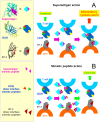Bacterial Superantigen Toxins, CD28, and Drug Development
- PMID: 30404186
- PMCID: PMC6265702
- DOI: 10.3390/toxins10110459
Bacterial Superantigen Toxins, CD28, and Drug Development
Abstract
During severe bacterial infections, death and disease are often caused by an overly strong immune response of the human host. Acute toxic shock is induced by superantigen toxins, a diverse set of proteins secreted by Gram-positive staphylococcal and streptococcal bacterial strains that overstimulate the inflammatory response by orders of magnitude. The need to protect from superantigen toxins led to our discovery that in addition to the well-known MHC class II and T cell receptors, the principal costimulatory receptor, CD28, and its constitutively expressed coligand, B7-2 (CD86), previously thought to have only costimulatory function, are actually critical superantigen receptors. Binding of the superantigen into the homodimer interfaces of these costimulatory receptors greatly enhances B7-2/CD28 engagement, leading to excessive pro-inflammatory signaling. This finding led to the design of short receptor dimer interface mimetic peptides that block the binding of superantigen and thus protect from death. It then turned out that such a peptide will protect also from Gram-negative bacterial infection and from polymicrobial sepsis. One such CD28 mimetic peptide is advancing in a Phase 3 clinical trial to protect from lethal wound infections by flesh-eating bacteria. These host-oriented therapeutics target the human immune system itself, rendering pathogens less likely to become resistant.
Keywords: B7-2 receptor; CD28 homodimer interface; CD28 receptor; bacterial superantigen toxins; costimulation; lethal toxic shock; receptor dimer interface mimetic peptides.
Conflict of interest statement
The funders had no role in the design of the study; in the collection, analyses, or interpretation of data; in the writing of the manuscript, or in the decision to publish the results.
Figures

Similar articles
-
Staphylococcal and Streptococcal Superantigens Trigger B7/CD28 Costimulatory Receptor Engagement to Hyperinduce Inflammatory Cytokines.Front Immunol. 2019 Apr 30;10:942. doi: 10.3389/fimmu.2019.00942. eCollection 2019. Front Immunol. 2019. PMID: 31114583 Free PMC article.
-
The homodimer interfaces of costimulatory receptors B7 and CD28 control their engagement and pro-inflammatory signaling.J Biomed Sci. 2023 Jun 28;30(1):49. doi: 10.1186/s12929-023-00941-3. J Biomed Sci. 2023. PMID: 37381064 Free PMC article.
-
Bacterial superantigen toxins induce a lethal cytokine storm by enhancing B7-2/CD28 costimulatory receptor engagement, a critical immune checkpoint.Receptors Clin Investig. 2017;4(1):e1500. Epub 2017 Jan 30. Receptors Clin Investig. 2017. PMID: 28286804 Free PMC article.
-
CD28: direct and critical receptor for superantigen toxins.Toxins (Basel). 2013 Sep 9;5(9):1531-42. doi: 10.3390/toxins5091531. Toxins (Basel). 2013. PMID: 24022021 Free PMC article. Review.
-
Subduing the Inflammatory Cytokine Storm.Int J Mol Sci. 2024 Oct 18;25(20):11194. doi: 10.3390/ijms252011194. Int J Mol Sci. 2024. PMID: 39456976 Free PMC article. Review.
Cited by
-
T Cell Immunity to Bacterial Pathogens: Mechanisms of Immune Control and Bacterial Evasion.Int J Mol Sci. 2020 Aug 26;21(17):6144. doi: 10.3390/ijms21176144. Int J Mol Sci. 2020. PMID: 32858901 Free PMC article. Review.
-
Targeting staphylococcal enterotoxin B binding to CD28 as a new strategy for dampening superantigen-mediated intestinal epithelial barrier dysfunctions.Front Immunol. 2024 Mar 6;15:1365074. doi: 10.3389/fimmu.2024.1365074. eCollection 2024. Front Immunol. 2024. PMID: 38510259 Free PMC article.
-
Overexpression of CD86 enhances the ability of THP-1 macrophages to defend against Talaromyces marneffei.Immun Inflamm Dis. 2022 Dec;10(12):e740. doi: 10.1002/iid3.740. Immun Inflamm Dis. 2022. PMID: 36444627 Free PMC article.
-
Expression patterns of CD28 and CTLA-4 in early, chronic, and untreated rheumatoid arthritis.J Clin Lab Anal. 2020 May;34(5):e23188. doi: 10.1002/jcla.23188. Epub 2020 Jan 6. J Clin Lab Anal. 2020. PMID: 31907973 Free PMC article.
-
A highly neutralizing human monoclonal antibody targeting a novel linear epitope on staphylococcal enterotoxin B.Hum Vaccin Immunother. 2024 Dec 31;20(1):2360338. doi: 10.1080/21645515.2024.2360338. Epub 2024 Jun 10. Hum Vaccin Immunother. 2024. PMID: 38857905 Free PMC article. Clinical Trial.
References
-
- Kaempfer R., Arad G., Levy R., Hillman D. Defense against biologic warfare with superantigen toxins. Isr. Med. Assoc. J. 2002;4:520–523. - PubMed
-
- United States Army Medical Research Institute of Infectious Diseases . In: Medical Management of Biological Casualties Handbook. 6th ed. Woods J.B., editor. United States Army Medical Research Institute of Infectious Diseases; Fort Detrick, MD, USA: 2005. [(accessed on 6 November 2018)]. Available online: http://www.dhhr.wv.gov/oeps/disease/Documents/USAMRIID_BlueBook.pdf.
Publication types
MeSH terms
Substances
Grants and funding
LinkOut - more resources
Full Text Sources
Research Materials

